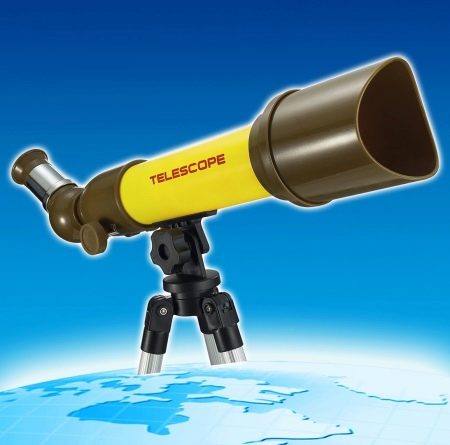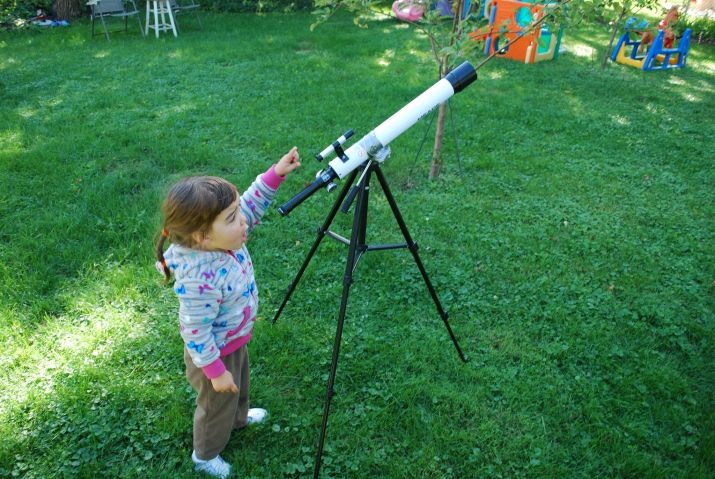Everything you need to know about telescopes for children

The children's telescope will help the child get to know the moon, stars and planets better. With it, you can see the beauty of space. Buying a telescope is a good opportunity for parents to support their child's passion for astronomy. Let's figure out what types of devices there are and what to look for when choosing.


general description
Astronomical telescopes were invented in the 17th century. Over time, many models of such devices appeared: for amateurs, professional astronomers and children. Children's telescopes differ from adults in magnification. They are compact and lightweight for easy use by a child.

All telescopes are similar in design. Let's consider its main components.
- Lens. This is a lens or mirror whose task is to collect light and project it to a point of observation.
- Eyepiece. It magnifies the subject several times and corrects lens distortion.
- Secondary mirror. Its function is also to enlarge the image.
- Additional mirrors. They output the image to the camera lens or eyepiece to provide the user with a comfortable viewing position.
- Crowbar. This is a support bracket for stable installation of equipment.

The simplest astronomical budget devices magnify an object up to 40 times. However, even such a multiplicity is enough for a child to see near the stars, the moons of Jupiter, the rings of Saturn and distant celestial bodies.


Views
To find a good telescope and support your child's desire to explore space, you need to become familiar with the types of devices: their features, advantages and disadvantages.
Mirrored
In another way, they are called reflectors.A concave mirror lens is a distinctive feature of such devices. To focus the picture, mirrored lenses collect light at a specific point.

Advantages of reflectors:
- affordable cost - the price of mirror telescopes is lower than lens and combined ones;
- they are compact, due to which they are easy to use;
- such devices do not have chromatic aberration - the acquisition of bright images by the edges of unnatural colors;
- allows you to view celestial bodies in difficult conditions, for example, with a nebula.

Disadvantage of reflectors: sensitivity to settings - they easily get lost when transporting equipment. Another disadvantage is an open pipe, due to which condensation can accumulate inside, dust can also get there.

Lens
Such devices are equipped with convex lenses built into the apparatus. They refract light streams, collect them at one point and focus.
Let's consider the advantages of such devices.
- Telescopes are easy to use - the child can quickly get used to and get carried away with the process.
- They have fast thermal stabilization. This process is understood as the equilibrium of temperature with the environment. Thanks to this feature, the warm air inside the pipes will not distort the picture and will not cause it to “shake”.
- High indices of color rendering and contrast.
- No need for self-adjustment. Lens telescopes are resistant to shaking during transportation, sudden temperature changes - all this does not lead to a malfunction of the settings.
- The design provides for a closed pipe, which means that the internal parts are reliably protected from dust and adverse weather conditions.
- The ability to view space and ground objects.

The disadvantages of telescopes include their size, because of which they take up a lot of storage space, as well as the impossibility of observing small and dim objects.
Combined
These telescopes combine lens and mirror equipment.
Their advantages:
- suitable for observing any space bodies: those that are located near and far;
- compact and lightweight, which makes it easy to carry and transport by hand;
- their pipe is closed, which means it is protected from dust and condensation.

Long-term thermal stabilization is inherent in such devices. The disadvantages also include the high cost and complex adjustment - a small child is not able to carry out self-adjustment.
The best models for a child
Based on customer reviews, we have compiled a rating of the best telescopes for children. Let's give a brief overview of them.
- Levenhuk Strike 50 NG. A compact 3.6 kg refractor with an azimuth mount. Easy handling and intuitive controls make it child-friendly. The lens of the device is made of optical glass. The finder with a large field of view on a telescopic tube greatly simplifies aiming at the object under study. Important technical characteristics: lens diameter - 50 mm, focal length - 600 mm, resolution - 2.8 angles. seconds, the minimum and maximum increase is 30 and 300, respectively.


- RT 776 Edu-Toys. Reflex telescope with a maximum magnification of 525 times. Equipped with a mirror-reflector with a diameter of 60 mm, eyepieces (sizes included for 20 mm, 12.5 mm, 9 mm, 4 mm), a 6x25mm viewfinder. Designed for children from 6 years old.

- Veber "Umka" 76/300. Table-top telescope with azimuth mount. Small and lightweight - it weighs 1.95 kg. Magnifies objects in the range from 15 to 75 times. Specifications: lens diameter - 76 mm, lens focal length - 300 mm. Includes: lunar filter, 2 eyepieces, finder, Barlow lens, accompanying documents.


- Levenhuk LabZZ MT2. A combined model that combines the functions of a microscope and a telescope. The minimum and maximum optical magnification is 75 and 900 times, respectively.The equipment is equipped with LED backlighting, which is powered by 2 AA batteries. The lens diameter is 50 mm, the focal length of the lens is 500 mm. The telescope comes with a reversing eyepiece, tripod, finder, test kits and other accessories.

- Edu Toys TS80. Lightweight and compact telescope for children from 5 years old. The weight of the device is 0.733 kg. Gives one magnification (45x). This is a refractor telescope with an azimuth mount and an optical finder included. Objective diameter - 40 mm, focal length - 600 mm.

Which telescope to choose?
When choosing a telescope, you need to take into account the child's age and temperament. However, until 4 years old, buying such a device is still not worth it. Observing celestial bodies is a lengthy process that requires concentration and concentration. Due to their age characteristics, four-year-old children are not ready for such an activity.
5 years is the age when a child becomes more intelligent, it is already easier for him to concentrate and concentrate. For young astronomers, manufacturers have created special telescopes with a magnification of 10 times. If the child is careful and thrifty, then parents can choose more serious models.


Telescopes equipped with additional lenses, brochures with useful information on astronomy are suitable for children 7-8 years old. For a seven-year-old child, you should not buy the cheapest devices with weak technical characteristics. Blurred fuzzy picture - this is the fault of many Chinese telescopes from the budget segment. Due to such a lack, the child may become disappointed and lose interest in the study of celestial bodies.

For 9-10 year olds who are eager to observe satellites, planets and stars, mirror-lens telescopes are suitable. The choice in favor of such equipment should be made if the parents are convinced that the study of astronomy is more than a passing hobby. Models that will allow not only observing, but also taking photos and videos of objects will be able to spur the child's interest.

When choosing a telescope, pay attention to these parameters.
- Weight and portability. The telescope should be light and compact so that it is convenient to move from one place to another and carry it.
- Easy assembly and disassembly - an important landmark.
- Optimal lens diameter from 60 to 90 mm.
- Reliability and unpretentious care. Refractive telescopes are more suitable for children. They are easy to use as they do not require regular adjustments.
- Mount type. For children over 8 years old, installations with an azimuth mount are preferred. It has 2 axes of rotation - horizontal and vertical. They make it possible to rotate the lens in azimuth and altitude, easily directing it to the desired point.

You should not choose expensive devices with an impressive range of additional options. Equipment with various accessories, a set of eyepieces, star charts, interesting and educational materials will be interesting for the child.
How to use it correctly?
Before observing the night sky, the telescope must be properly set up. All operating instructions contain the same recommendations.
To complete the configuration, you need:
- find a distant object (it must be at least 1 km away from the user) and point the telescope so that it is in the middle of the eyepiece;
- fix the position of the telescope;
- look through the viewfinder, achieve clarity and center the subject by adjusting the fine adjustment screws;
- check the picture in the main telescope again.

Even if the settings were made correctly, due to the glow in the city, the child will not be able to see all the beauty of the heavenly bodies. It is best to study space objects outside the city: in villages or outdoors in the mountains.









